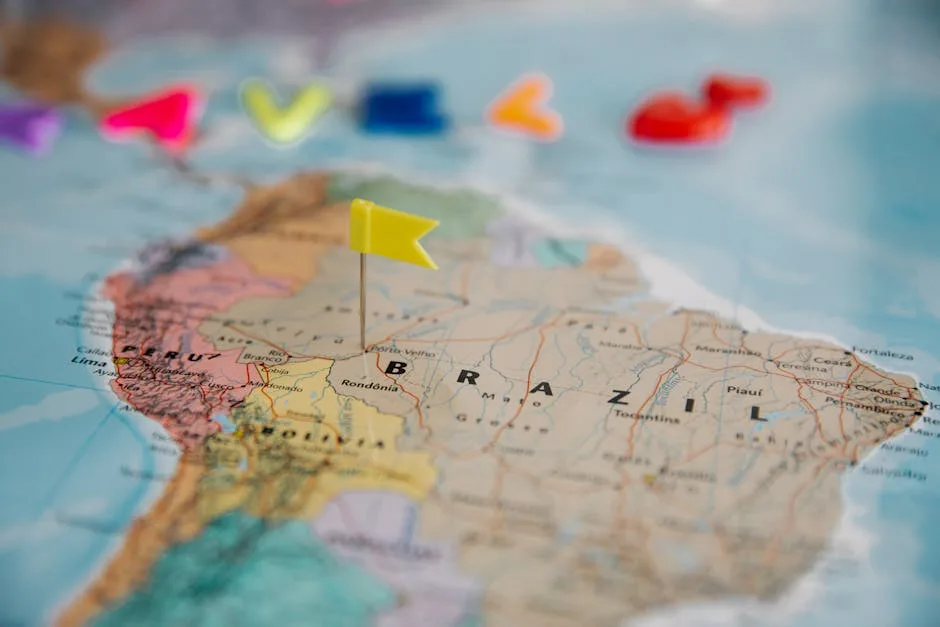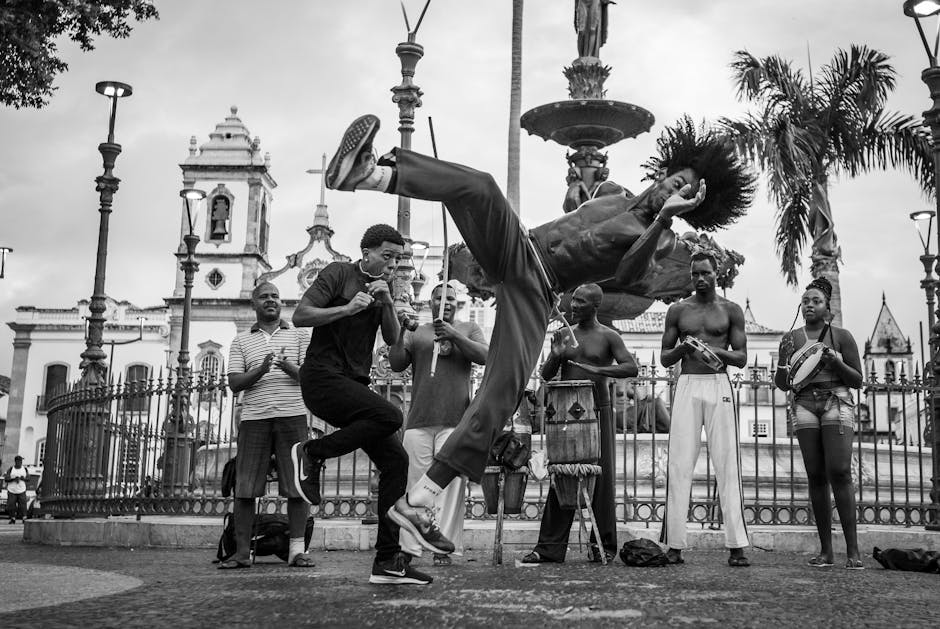- Getting Around Brazil: A Quick Overview
- Buses: The Backbone of Brazilian Intercity Travel
- Why Choose Buses in Brazil?
- Understanding Bus Classes
- Booking Your Bus Tickets
- Navigating Bus Terminals (Rodoviárias)
- Flights: Covering Vast Distances Quickly
- When to Choose Flights?
- Major Brazilian Airlines
- Booking Strategies for Flights
- Airport Logistics
- Road Trips: The Ultimate Adventure
- Why Road Trip in Brazil?
- Renting a Car
- Driving in Brazil: What to Expect
- Suggested Road Trip Regions
- Combining Modes: The Smart Traveler's Approach
- Essential Tips for Any Brazilian Journey
- Language Basics
- Safety Considerations
- Packing Essentials
- Connectivity
- Money Matters
- Flexibility and Patience
- Regional Nuances
brazil is a country of epic proportions, a vibrant tapestry of cultures, landscapes, and rhythms that stretches across nearly half of South America. from the sun-drenched beaches of the Northeast to the bustling metropolises of the Southeast, and the wild beauty of the Amazon, there’s a world to explore. But with such vast distances, figuring out how to get from one incredible destination to another can feel a bit daunting at first. Don’t worry, friend! As your friendly guide, I’m here to help you navigate the ins and outs of intercity travel in Brazil, whether you’re dreaming of scenic bus rides, quick flights, or an adventurous road trip. Let’s make your brazilian journey as smooth and enjoyable as possible!
Getting Around Brazil: A Quick Overview
When planning your adventure, you essentially have three main ways to hop between Brazil’s cities: buses, flights, and renting a car for a road trip. Each has its own charm, advantages, and considerations. Your choice will likely depend on your budget, time constraints, the distance you need to cover, and your thirst for adventure.
For shorter to medium distances, or if you’re on a budget and love soaking in the local scenery, buses are often your best bet. If time is of the essence and you’re covering vast swathes of the country, domestic flights will be your speedy saviour. And for those who crave ultimate flexibility, the thrill of discovery, and the freedom to explore at your own pace, a road trip can be an unforgettable experience.
Buses: The Backbone of Brazilian Intercity Travel
Imagine a country where bus travel isn’t just a budget option, but a genuinely comfortable and extensive network connecting virtually every town and city. Welcome to Brazil! The bus system here is incredibly robust, often providing a more authentic and cost-effective way to see the country.
Why Choose Buses in Brazil?
- Extensive Network: Buses reach places flights don’t, often taking you right into the heart of a town.
- Cost-Effective: Generally the most economical way to travel, especially for solo travellers or those on a tight budget.
- Comfort Levels: Brazilian buses are surprisingly comfortable, often rivalling domestic flights for legroom and seat recline.
- Scenery: You’ll get to see the changing landscapes up close, from coastal views to lush forests.
Understanding Bus Classes
This is where it gets interesting! Brazilian buses come in several classes, so you can pick one that suits your comfort needs and budget:
- Convencional: The standard service, basic seats, often with air conditioning. Good for shorter trips.
- Executivo: A step up, with more comfortable, reclining seats and often a bit more legroom. Great for medium-range journeys.
- Semi-Leito: These seats recline significantly, almost like a business class airline seat, often with footrests. Perfect for overnight journeys where you want some decent sleep.
- Leito: The top tier! These are almost fully flat beds, often with blankets, pillows, and sometimes even individual entertainment screens. If you’re tackling a long overnight journey, splurging on a Leito seat is absolutely worth it for a proper rest.
Booking Your Bus Tickets
You have a few options:
- Online: Websites like ClickBus, Buson, and Guichê Virtual allow you to search routes, compare companies (like Cometa, 1001, Gontijo, Util, Catarinense), and book tickets in advance. This is highly recommended, especially for popular routes or during holidays.
- At the Rodoviária: The bus terminal (known as a rodoviária) is where you’ll find ticket counters for various companies. You can buy tickets directly there, but be prepared for potential queues, especially during peak times.
A little tip: Always aim to book a few days in advance if your travel dates are fixed, as popular routes and premium seats (Leito, Semi-Leito) can sell out quickly.
Navigating Bus Terminals (Rodoviárias)
Brazilian rodoviárias can be bustling hubs, especially in larger cities. They’re usually well-organized with ticket counters, waiting areas, restrooms, and often food stalls or restaurants. Pay attention to your gate number (plataforma) and listen for announcements. Keep your belongings close, just like in any busy transport hub.
When you arrive, your luggage will be tagged and stored in the bus’s undercarriage. Make sure to keep your luggage tag safe, as you’ll need it to retrieve your bags at your destination.

Flights: Covering Vast Distances Quickly
Brazil is colossal, and sometimes, taking a bus for a 24-hour journey just isn’t feasible or desirable. That’s where domestic flights come in! They’re efficient, increasingly affordable, and connect all major cities and many smaller towns.
When to Choose Flights?
- Long Distances: Essential for crossing the country (e.g., Rio de Janeiro to Manaus, São Paulo to Salvador).
- Time Constraints: If you have limited vacation time, flying saves precious hours or even days.
- Comfort Preference: While buses are great, flights are generally quicker and provide a different kind of travel experience.
Major Brazilian Airlines
The main players in Brazil’s domestic flight market are:
- LATAM: Often considered the largest, with a broad network and good service.
- GOL: A popular low-cost carrier, great for finding competitive prices.
- Azul: Known for connecting more regional airports, often providing a unique network to smaller towns.
Booking Strategies for Flights
- Book in Advance: This is probably the biggest piece of advice. Domestic flight prices in Brazil can skyrocket closer to the travel date, especially during peak seasons or holidays. Aim to book several weeks, or even months, ahead.
- Use Price Comparison Sites: Websites like Google Flights, Skyscanner, and Decolar (a Latin American equivalent) are excellent for comparing fares across different airlines and finding the best deals.
- Check Baggage Policies: Most domestic tickets in Brazil do not include checked luggage, so be prepared to pay extra or travel with carry-on only. Always double-check before booking.
- Consider Flight Passes: If you’re planning multiple domestic flights, some airlines or travel agencies offer flight passes that can be more economical than buying individual tickets.
Airport Logistics
Major airports in Brazil are modern and efficient. Keep in mind that some cities, like São Paulo, have multiple airports (GRU and CGH). Always confirm which airport you’re flying into or out of to avoid last-minute confusion!
Factor in travel time to and from the airport. Taxis, ride-sharing apps (like Uber and 99), and airport shuttle buses are readily available in most major cities.
Road Trips: The Ultimate Adventure
For those who love the open road, the freedom to stop wherever a stunning view catches their eye, and the joy of discovering hidden gems, a road trip in Brazil is an incredible experience. While it requires more planning and a spirit of adventure, it can be the most rewarding way to explore certain regions.
Why Road Trip in Brazil?
- Flexibility: You set your own schedule, detours, and pace.
- Scenic Routes: Discover breathtaking landscapes and coastal drives that buses and planes miss.
- Hidden Gems: Access smaller towns, national parks, and remote beaches that are harder to reach via public transport.
Renting a Car
Major international rental companies (Hertz, Avis, Europcar, Localiza, Unidas) operate in Brazil. Here’s what you need to know:
- Requirements: You’ll need a valid driver’s license from your home country (an International Driving Permit is recommended, though not always strictly required for short stays, it’s good to have for peace of mind), a credit card in the driver’s name, and typically be over 21 (sometimes 25).
- Insurance: Absolutely essential! Ensure your rental includes comprehensive insurance (CDW – Collision Damage Waiver, and theft protection). It’s often wiser to purchase the full coverage offered by the rental company.
- Booking: Book in advance, especially during high season, to secure a good vehicle and rate.
Driving in Brazil: What to Expect
- Road Conditions: Major highways (rodovias) connecting big cities are generally well-maintained, but quality can vary significantly on smaller, more remote roads. Expect some potholes, especially in rural areas or during rainy seasons.
- Tolls (Pedágio): Many highways, particularly in the south and southeast, are toll roads. Keep some cash (Brazilian Reais) handy, as not all tolls accept cards, though electronic payment systems are becoming more common.
- Fuel: Gas stations are plentiful. Brazil primarily uses gasoline (gasolina) and ethanol (etanol or álcool). Many cars are flex-fuel, meaning they can run on either. Diesel (diesel) is for specific vehicles.
- Navigation: GPS apps like Google Maps or Waze are indispensable. Download offline maps when possible, as cell service can be spotty in certain regions.
- Safety: Like anywhere, exercise caution. Avoid driving at night, especially on rural roads or in less familiar areas, due to varying road quality and potential safety concerns. Keep car doors locked, and valuables out of sight.
Suggested Road Trip Regions
- Minas Gerais: Explore charming colonial towns like Ouro Preto, Tiradentes, and Mariana. The roads here weave through rolling hills and offer incredible historical insights.
- The Green Coast (Costa Verde): Between Rio de Janeiro and São Paulo, a beautiful drive with towns like Paraty and Ilha Grande accessible by ferry from Angra dos Reis.
- Northeast Beaches: Imagine driving along the stunning coastline, hopping from one incredible beach to another in states like Bahia or Ceará.

Combining Modes: The Smart Traveler’s Approach
Often, the best strategy is to mix and match! For example, you might fly from São Paulo to Salvador (a long distance), then take a comfortable bus to explore the smaller towns and beaches of Bahia. Or, fly into a major hub, rent a car for a few days to explore a specific region (like the Chapada Diamantina), and then fly out from another city. This hybrid approach often gives you the best of both worlds: speed for long hauls and flexibility for local exploration.
Essential Tips for Any Brazilian Journey
Language Basics
While many people in tourist areas might speak some English, knowing a few basic Portuguese phrases will go a long way. Brazilians are incredibly appreciative when you try! Things like Olá (Hello), Obrigado/a (Thank you), Por favor (Please), Onde é…? (Where is…?), and Quanto custa? (How much does it cost?) will be immensely helpful. Google Translate is your friend!
Safety Considerations
Brazil is generally safe for tourists, but like any large country, it has its challenges. Be aware of your surroundings, especially in crowded areas or at night. Avoid displaying expensive jewellery or electronics. Use reputable transport services, and always trust your gut feeling. Most importantly, remain vigilant but don’t let fear overshadow the incredible warmth and beauty of the country.
Packing Essentials
Think light and versatile! Brazil is mostly tropical, so breathable clothing is key. Don’t forget sunscreen, insect repellent (especially if heading to more rural or Amazonian areas), a hat, and comfortable walking shoes. A portable charger for your phone is always a good idea.
Connectivity
Getting a local SIM card (from carriers like Vivo, Claro, or TIM) is highly recommended. It’s inexpensive and provides reliable data for navigation, communication, and staying connected. Wi-Fi is generally available in hotels, restaurants, and some public places.
Money Matters
The local currency is the Brazilian Real (BRL). Credit and debit cards are widely accepted, especially in cities and larger towns. However, it’s always wise to carry some cash for smaller purchases, street vendors, or in more remote areas. ATMs are widely available, but always use them in well-lit, secure locations.
Flexibility and Patience
Things in Brazil sometimes operate on a slightly different time scale than you might be used to. Buses can be delayed, flights might be re-scheduled, and plans can change. Embrace the relaxed pace, stay flexible, and remember that delays are often just another part of the adventure. A positive attitude will make all the difference!
Regional Nuances
It’s worth noting that travel experiences can vary significantly across Brazil’s diverse regions. In the well-developed South and Southeast, you’ll find excellent infrastructure, a wide array of bus options, and frequent flights. The Northeast offers good coastal connections but might have varying road quality inland. The North, particularly the Amazon region, relies heavily on river travel for local connections, and flights are often the only practical way to cover vast distances between major cities. Always research the specific region you’re visiting for tailored advice on local transport.
Brazil is an experience like no other, full of unforgettable moments waiting to happen. With this guide in hand, you’re now better equipped to choose your travel style and embark on an incredible journey across this magnificent country. Happy travels, or as Brazilians say, Boa Viagem!





